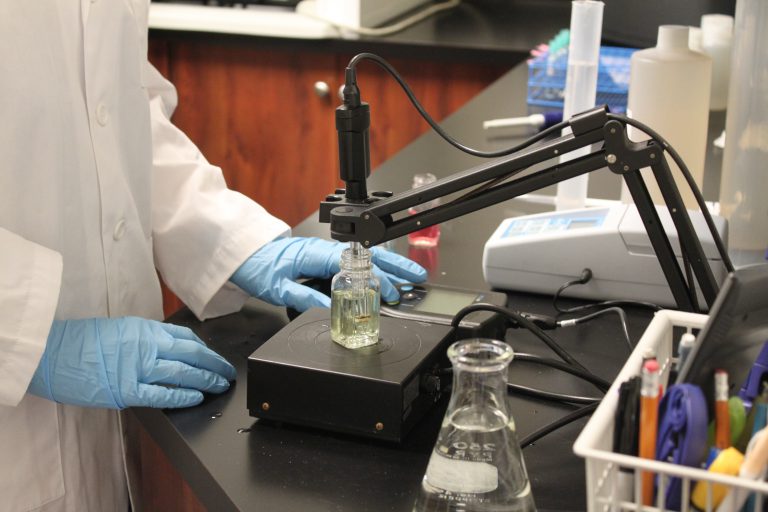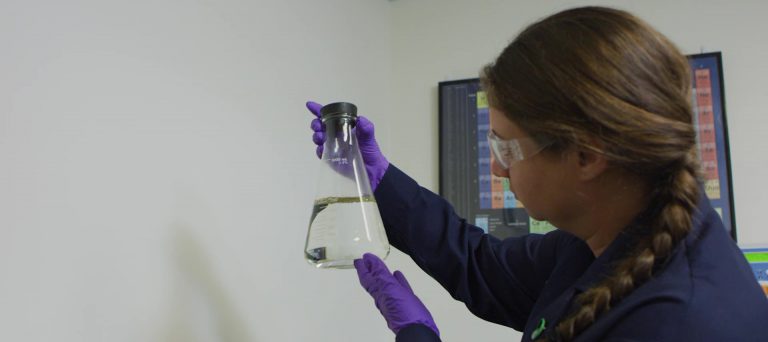
Common Water Chemistry Tests
Most of the lake and pond issues that we face can be traced to an imbalance in water quality—so understanding the chemical and biological constituents and demands on your waterbody is essential. SOLitude looks beyond surface-level symptoms with water quality assessments that reflect your unique goals and budget. Your assessment will dive deep into the source of your aquatic problems and set the framework for a long-term management program.
Assessment
Each assessment is thoughtfully designed to uncover relevant, actionable combinations of water quality data, including many of the parameters below:
Alkalinity/Hardness – Alkalinity indicates the water’s capacity to resist changes in pH. Good buffering capacity can limit dangerous pH swings caused by the introduction of highly acidic or basic substances. Total hardness is defined as the concentration of calcium and magnesium in the water. Calcium is necessary for proper fish egg and native insect development.
Ammonia – Ammonia can be toxic to fish and other animals. The level of toxicity, however, is based on the total ammonia concentration, pH, and temperature. Higher levels usually mean that a lake or pond is being exposed to unusual discharges, while lower levels help limit plant and algae growth. Multiple management strategies are available to help manage ammonia levels.
Chloride/Salinity – The Chloride ion is one of the major inorganic anions in water and wastewater. Although chloride is essential to plants in very low amounts, it can cause toxicity to sensitive crops at high concentrations. Water with high salinity is toxic to plants and may become hazardous to the ecosystem. High levels of Chloride or Salinity may be caused by the proximity of the lake to the ocean or low water levels, which cause salts to become more concentrated within the waterbody.
Color – The measured value for color reflects decomposition of organic matter in a lake or pond. This organic matter may be the result of decaying plankton and aquatic plants or other inputs from the surrounding watershed.
Conductivity and total dissolved solids (TDS) – These measurements estimate the total concentration of ionized substances dissolved in the water. The inorganic anions dissolved in water include carbonates, chlorides, sulfates and nitrates, while inorganic cations include sodium, potassium, calcium and magnesium. Water TDS and conductivity levels vary naturally based on the specific characteristics of the waterbody (e.g. geology, proximity to the sea, etc). A significant and acute increase in conductivity may indicate a recent increase in domestic or industrial pollution. High dissolved solids may cause irrigation water to stain vehicles and other surfaces in the general vicinity.
Iron – When concentrations exceed 0.1 mg/L, iron precipitates on exposure to air, decreasing pond clarity, potentially clogging irrigation pipes, and encouraging iron bacteria. This affects the flavor of fish and water. Levels greater than 0.3 mg/L can cause staining on buildings and sidewalks when the water is used for irrigation.
pH – The pH value of a body of water expresses its tendency to donate or accept hydrogen ions on a scale of 0 (very acidic) to 14 (very basic). Natural waters generally range from pH 6.5 to pH 8.5 but can vary. Water with long-term low or high pH readings can be corrosive, causing potential problems with irrigation equipment or structures. Aquatic animals are greatly affected by changes in pH.
Total Phosphorus and Phosphate – Phosphorus is a naturally occurring component of aquatic systems and is necessary for a balanced ecosystem. Elevated levels of phosphorus, however, can cause shifts in this balance and is the most common cause of the undesirable growth of aquatic weeds and algae. The discharge of treated wastewater and agricultural drainage into a lake or pond will increase a the waterbody’s phosphorus levels. Lawn and landscape fertilizer runoff is another major source of phosphorus and their use should be avoided near the water. In such cases, multiple management strategies may be required to lower phosphorus. Phosphate (PO43-) refers specifically to the dissolved form of phosphorus in the water column. Phosphate is the most biologically active form of phosphorus. Phosphate levels are expected to range from 10ppb to 50ppb in healthy freshwater systems.
Total Nitrogen – Nitrogen is natural nutrient that occurs in aquatic ecosystems. The ratio of nitrogen to phosphorus can be used to predict the type of algae present in a waterbody. When the N:P ratio is >75, the chances of Harmful Algal Blooms and filamentous algae mats increases.
Turbidity/Clarity – Lack of clarity, known as turbidity, in natural waters is caused by the presence of suspended solids such as silt, clay, fine organic and inorganic matter, plankton and other microscopic organisms. The turbidity test measures an optical property of the water sample and is used as an index of water clarity. Elevated turbidity levels are often due to increased runoff, higher flow, or construction activity in the drainage basin. The degree to which turbidity affects wildlife depends on both the level of turbidity and the duration of exposure. Low turbidity levels can begin to stress fish within a few hours.












